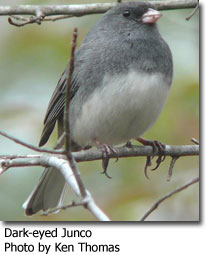Dark-eyed Junco
Junco hyemalis
 Description & Range:
Description & Range:
Dark-eyed juncos are medium-sized sparrows that have multiple color patterns specific to the region where they are found. However, most have a dark-gray or brown head and body with a white belly. Dark-eyed juncos have a rounded head, a short, stout, pink bill and a fairly long, conspicuous tail with white outer tail feathers.
Dark-eyed juncos breed in Canada and higher-elevation mountain forests in the U.S. . However, as the temperatures begin to drop, these plump sparrows leave most of their Canadian haunts and are abundant in much of the United States. Some juncos that inhabit the Appalachian Mountains, including sections of Maryland’s Garrett County, are year-round residents. Dark-eyed juncos are considered some of the most common birds in the United States, and one estimate sets this junco’s total population at approximately 630 million individuals!
Habitat:
Typically, dark-eyed juncos breed in northern areas in late spring and summer. They generally can be found in conifer forests consisting of pines, spruces and a mix of hardwoods. In the fall and winter, these birds can be commonly found in forest edges and shrublands, as well as suburban environments that have ample underbrush for shelter.
Diet:
Dark-eyed juncos rely on seeds for as much as 75% of their diet. Juncos readily come to feeders and will eat millet and sunflower seeds. During the breeding season, dark-eyed juncos also eat insects including beetles, moths, butterflies, caterpillars, ants, wasps, and flies. When foraging for food, dark-eyed juncos typically hop along the ground while pecking or scratching at the leaf litter.
Reproduction:
During the breeding season, males are extremely territorial towards other males which they will chase away. During courtship, male juncos will perform a small display to show off their wings and tail while also offering nest materials to potential mates. After mating, females will build their nests out of grass and pine needles on the ground or in a depression made of twigs, grasses and ferns. After building a nest, females lay 3-6 eggs, which take up to two weeks to incubate. After hatching, the young take another 2 weeks to develop before they fledge from the nest. Juncos can have 1-3 broods per year.
Sounds:
Juncos make a high, short chip note that is often repeated in rapid succession when they fly and in a slower cadence as they forage. Male dark-eyed juncos sing an even, musical trill of 7-23 notes that lasts up to 2 seconds. Their song is similar to the songs of both the chipping sparrow and the pine warbler.
Behavior:
In the winter, dark-eyed juncos become less territorial than on their breeding grounds and often form fairly large flocks. Juncos also will forage as “mixed flocks” with other species, such as sparrows and bluebirds. Junco flocks typically have a hierarchy or pecking order, and earlier arrivals tend to rank higher in the group than later arrivals.